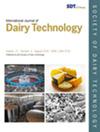Seasonal microbial dynamics influence on the biochemical identity of artisanal colonial cheese from southern Brazil during ripening
Abstract
Background
Artisanal Colonial Cheese (ACC), a traditional Brazilian dairy product, represents a complex interplay between microbial ecology, seasonal climate and artisanal practices. ACC has few studies related to its physicochemical and microbiological composition, which would assist in the standardisation and legislation of this product.
Aim
This study investigated how seasonal variations (summer vs. winter) influence ACC's microbial dynamics, biochemical profile and nutritional quality during 21 days (1, 7, 14, 21) of ripening.
Methods
Using high-throughput sequencing, gas chromatography and capillary electrophoresis analyses, the microbial communities, fatty acids profiles, aliphatic organic acids (AOA) and volatile compounds of eight different cheeses were characterised.
Major Findings
Summer ACCs exhibited Lactococcus-driven dominance (64.95%–69.73%), correlating with elevated unsaturated fatty acids (UFAs: 18.035–32.900 g/100 g oleic acid), favourable hypocholesterolemic/hypercholesterolemic (H/H) ratios (0.861 vs. winter 0.330) and ester-rich volatile profiles (e.g. ethyl butanoate). Winter samples showed dynamic microbial succession: early Raoultella (42.28%–39.74%) and Rahnella (11.96%–12.78%) transitioned to Leuconostoc dominance (9.33%–16.37%), yielding higher short-chain fatty acids (SCFAs: caproic, caprylic acids) and branched alcohols (e.g. 3-methylbutanol, 60% of W21 volatiles). Fungal communities further differentiated seasons, with Debaryomyces genus suppressing spoilage fungi in winter and Diutina genus enhancing lipolysis in summer. Nutritional indices linked summer ACCs to improved anti-atherogenic properties, while winter's microbial diversity showed more complex AOA pathways (propionic and succinic acids).
Scientific Implications
These findings underscore ACC's microbial terroir, where seasonal microbiota govern its biochemical identity, providing a scientific basis for geographical indication protocols. Furthermore, information on biochemical and microbiological transformations promoted a better understanding of the maturation period of this product.


 求助内容:
求助内容: 应助结果提醒方式:
应助结果提醒方式:


